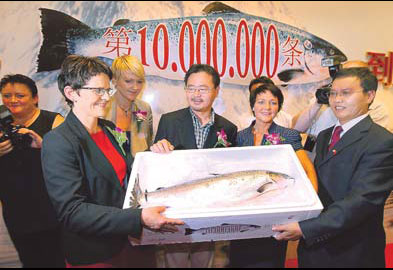Business
Seafood sector rides on growing Chinese market
By Zhang Xiaomin (China Daily)
Updated: 2010-11-04 11:47
 |
Large Medium Small |
|
|
DALIAN, Liaoning- More overseas seafood producers and supplies are eyeing the Chinese market, following its growth in the past few years.
| ||||
The Chinese market is getting stronger because the country is becoming more prosperous and more people can afford both domestic and imported seafood, Redmayne said.
"Chinese people are importing more and more seafood even though the prices of some products, such as salmon and king crab, are rising," he said.
Norway alone exported 19,300 tons of salmon, valued at 895 million yuan ($133.97 million), to the Chinese mainland and Hong Kong in the first eight months, figures released by the Norwegian Seafood Export Council (NSEC) showed. The imports increased 35 percent in volume and 53 percent in value year-on-year.
"Some 130,000 tons of Norwegian seafood were imported to China in 2009, valued at 1.9 billion yuan," Ashild Nakken, director of NSEC China, told China Daily.
"2010 could become another record-breaking year as the value already reached 1.9 billion yuan in September."
Nakken said China will soon surpass Japan and become the most important market in Asia for Norwegian salmon.
"We are very happy that the Chinese people like Norwegian salmon. They buy more and pay more," she said.
Compared with the rising imports, China's seafood exports have been falling slightly since 2007, Redmayne said.
"It's partly because of the rising labor cost. Also, some imported products for reprocessing are not exported but stay in China for domestic consumption," Redmayne said.
Liaoning Province Dalian Ocean Fishery Group Corp (Liaoyu Group), previously an export-oriented pelagic fishery corporation, is now paying more attention to the domestic market.
"Exports are becoming less competitive with the potential appreciation of the yuan and rising labor costs. We are now rebalancing the two markets. We not only sell our own products in the domestic market, but also act as agents for overseas seafood products," said Lu Daqiang, vice-general manager of Liaoyu Group.
The 15th China Fisheries and Seafood Expo, held from Nov 2 to 4, is organized by the agriculture council of the China Council for the Promotion of International Trade. Sea Fare Expositions Inc is the overseas co-organizer of the expo.
A record number of overseas exhibitors are attending this year's expo, organizers said. It features 700 companies from more than 30 countries and regions, including the US, Australia, Russia, Vietnam and Japan.

